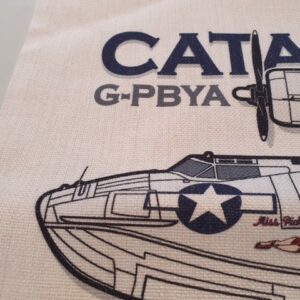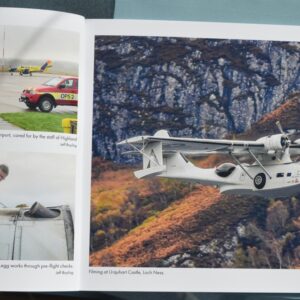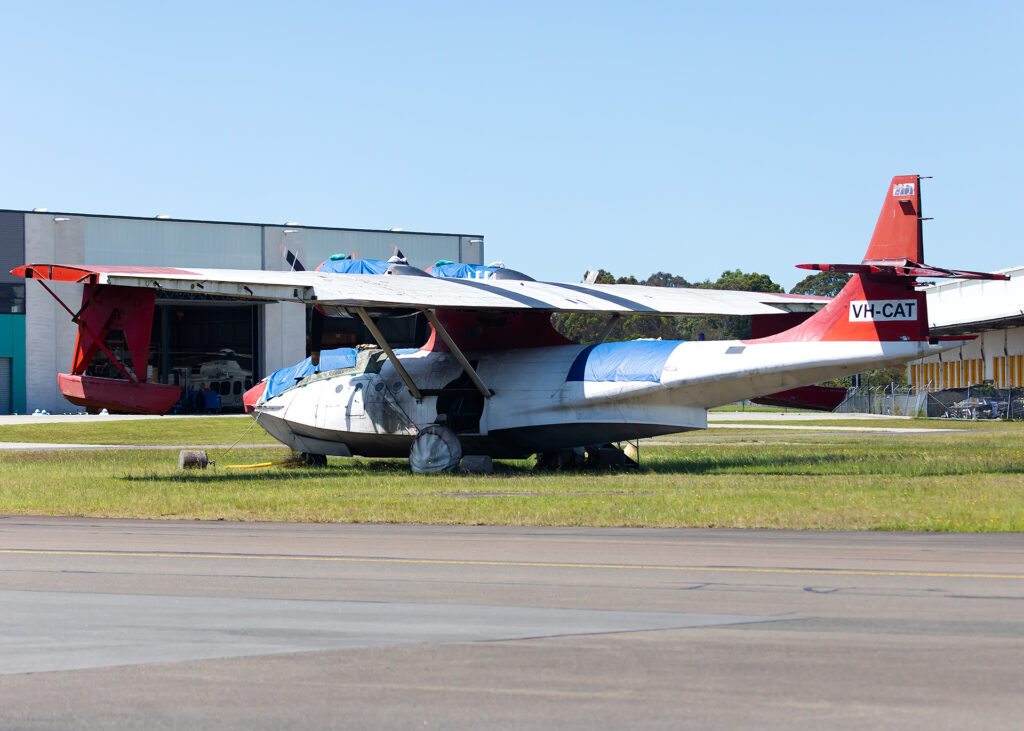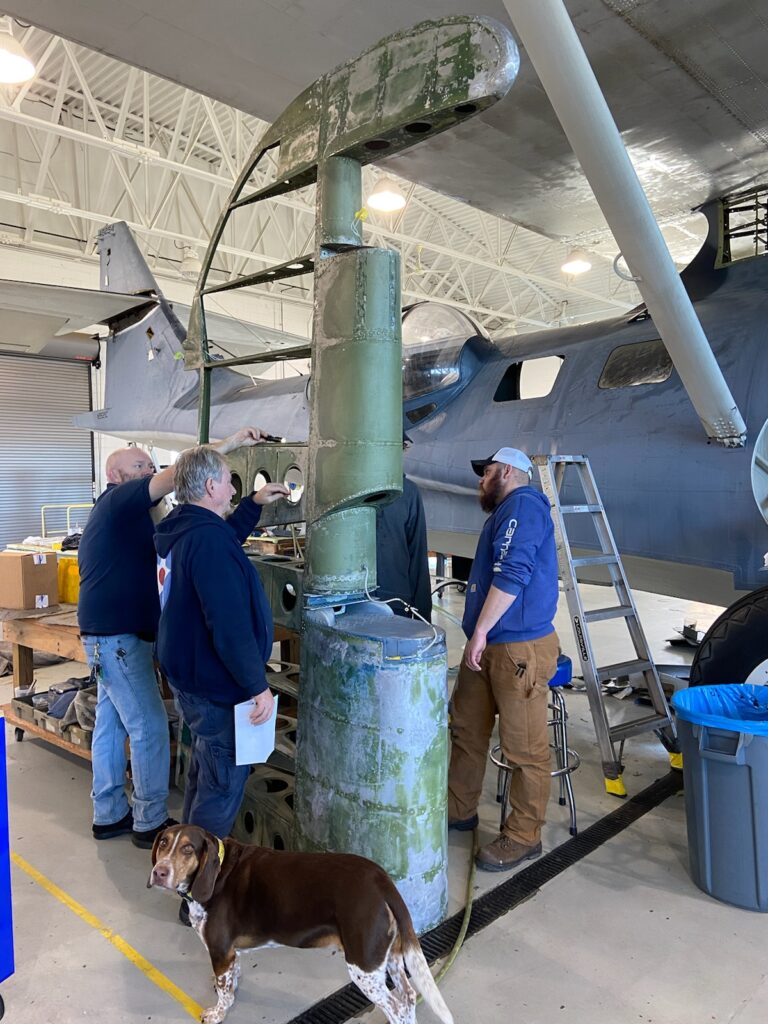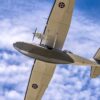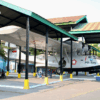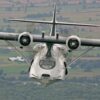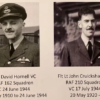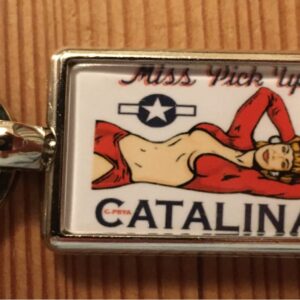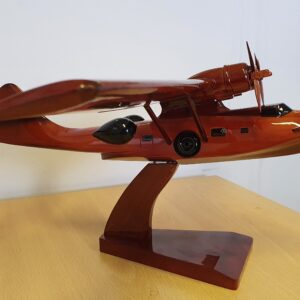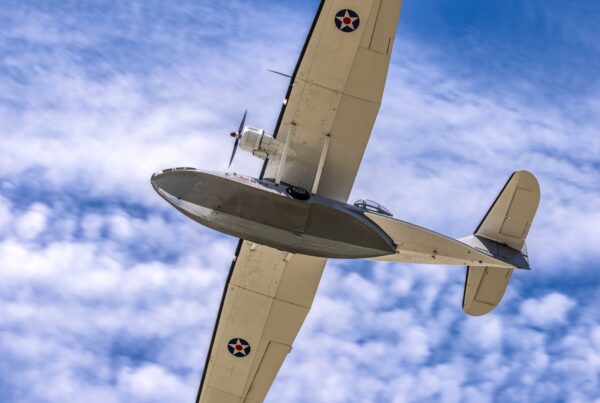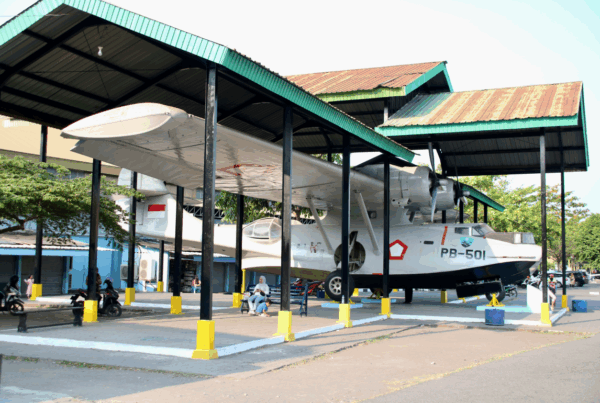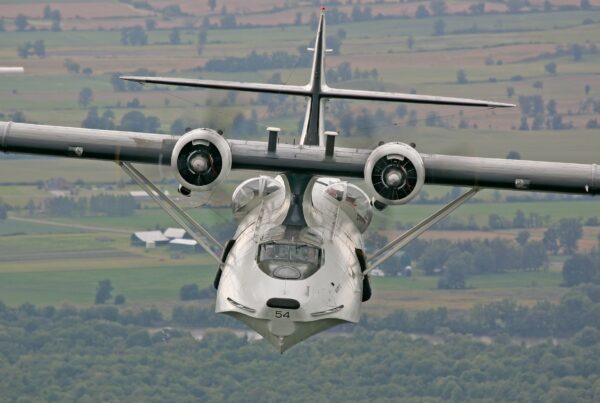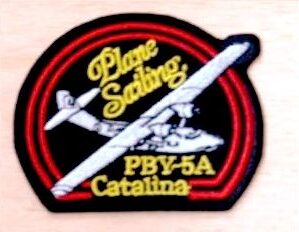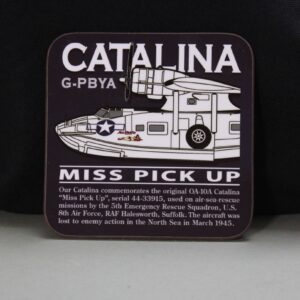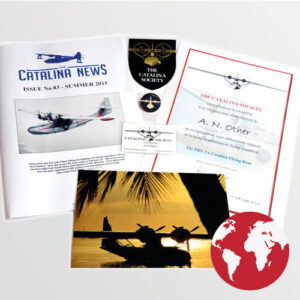Many surviving Catalinas around the world are now, or about to be, 80 years old although some will have to wait until next year. For such an old aircraft, there is still plenty of news – this article originally appeared in Issue 99 of The Catalina News, the magazine sent to subscribing members of The Catalina Society. But first, a brief note on designations. To be consistent, I refer throughout to the designation applied when an individual aircraft was built and not, unless specified, the designation under which it currently, or last, registered.
Let’s start in Australia where there has been plenty going on. The Powerhouse Museum in Sydney, NSW is situated in a converted electric tram power station first built in 1902 at Ultimo. It has been home to one of only two complete non-amphibious Catalinas in the world (and the only extant PB2B-2 model) since 1961, when Sir PG Taylor donated it to the museum. VH-ASA Frigate Bird II, built by Boeing Aircraft of Canada Ltd-, is a very famous aircraft, having been used by the Australian airman Captain Patrick Gordon Taylor in 1951 for the first ever flight between Australia and Chile, a feat immortalised in his excellent book Frigate Bird. Since 1987, it has been suspended from the roof of the Powerhouse Boiler Hall as the centrepiece of the museum’s transport exhibition but last year it was lowered to a position just above the ground. The move enabled Frigate Bird II to be much more accessible as part of an exhibition devoted to the aircraft and to PG Taylor and his pioneering flights including that to South America. In addition to the Catalina itself, the supporting exhibits, including many items acquired from the Taylor family, featuring models, photographs, uniforms, some internal fittings from Frigate Bird II, philatelic covers, various letters and papers, a mail bag used on the Chile flight, various navigation instruments and logbooks. The Catalina exhibition will run until the end of this year and Frigate Bird II will remain in her lower position until then. There has been some controversy about the Catalina’s future beyond the exhibition. In June 2020, plans to dismantle and move it to the Museum’s premises at Parramatta in Sydney’s western suburbs were announced but these were cancelled after public resistance and a rethink. However, dismantling does still seem to be on the cards.
A Powerhouse representative told me in April this year that: ‘The New South Wales Government has made a public commitment to keep several key, iconic collection items at the Powerhouse Ultimo including the Catalina, the Boulton and Watt steam engine and Locomotive No. 1. During the Powerhouse Ultimo renewal, these objects will need to be temporarily transported and stored in our state-of-the-art storage facilities at Powerhouse Castle Hill. However, upon completion, they will be returned to Ultimo and be publicly accessible once more.’ Let us hope that the period of dismantled storage will not be a long one and that this famous and unique Australian Catalina will be undamaged and back on display soon.
As previously reported in The Catalina News Issue 97, the Rathmines Catalina Association (RCA) has had to shelve plans to establish a centre to commemorate Royal Australian Air Force operations at the wartime base of Rathmines after the Lake Macquarie Council decided not to support the project. The longer-term plan is now to join forces with the RAAF Williamtown Aviation Heritage Centre near Newcastle, NSW. In the meantime, the RCA’s PBY-5A Catalina Our Girl, formerly registered in the USA as N7238Z, has been moved from its previous location in the Kilaben area between Sydney and Newcastle, NSW to a new indoor location at Beresfield in the suburbs of Newcastle where a long-term lease has been taken out on a large warehouse building. The move took place on December 13th last year and both hull and wing are now on site. Steve Wenban, the Rathmines Catalina Restoration Coordinator, told us that: ‘the Catalina now resides in a much better environment. Although the work had to stop for a short period of time while the Catalina and all equipment was moved and fitted into the new workshop, the team is now back at full speed and some great advances have been made. The middle of the wing is starting to look like a new centre section and Warren Easterbrook has been painting the completed section. Although there is still a long way to go, a very diligent crew is making it happen.’ Steve has been doing terrific work on restoring the hull, most recently on the ‘clipper’ bow section so that it can accept a bow turret and this sheet metal work continues apace, as does work to correct post-war mods to bring the Cat’ back to WW2 configuration. He had gained practice for the bow and turret area by doing similar work when at Kilaben on the unidentified Catalina front hull owned by CNAPG (the Clyde North Aircraft Preservation Group). This relic has done the rounds in recent years and been displayed at a number of locations but moved from Kilaben to a new location at Cressy, Victoria on December 11th. It has been fitted out by RCA as a mobile theatre.
Still in New South Wales, the airworthy PBY-6A VH-PBZ Felix based at Albion Park/Shell-harbour Airport, around 100 kms South of Sydney with Historic Aircraft Restoration Society (HARS) has recently been temporarily grounded and placed in the back of the HARS hangar whilst work is carried out to bring her back to airworthy status. Here is an update from Peter Costigan, a volunteer at HARS and a crew member on VH-PBZ: ‘During our annual inspection we found some issues inside the port inner trailing edge section and a decision was made to remove it and also to remove the fabric covering allowing for a more detailed inspection. Once stripped, further damage was found, including some dodgy repairs from its earlier lives. We are currently sourcing, locally, some replacement rib channel material to carry out the repairs. The square tube material is available in the USA and this will take a few months to arrive, so more delay. Our current plan is while this port inner trailing edge section is off being repaired and recovered we will also remove the starboard inner trailing edge section for a more detailed inspection as both these sections are subject to prop wash.
Hopefully we may not need to strip and recover the starboard inner trailing edge section depending on what the detailed inspection reveals. To the best of our knowledge, it is in better condition than the one we removed.’
‘With the inboard trailing edge sections removed the outer sections are going to be inspected as thoroughly as, with the inboard section removed, there is better inspection access possible, but we expect they should be in good condition as they are not in the prop wash. The joys of fabric covered wing sections! Fortunately, we have a group within HARS who have trained in fabric repair and are turning out some amazing work. The fabric on this aircraft was attached to the ribs with small screws and then taped over. One member worked out that we have removed more than 1,500 screws plus at least as many rivets from this port inner trailing edge section alone and have to put them all back later. The port inner trailing edge section is 6.4 metres long and around 2 metres wide. The fabric covering is Ceconite, so is a modern material and easy to match. We suspect the fabric was last renewed after the Catalina suffered an accident in Chile in January 1986.’
‘Removing the port inner trailing edge section also gave us a good look at the rear spar and we are thrilled with its condition. We expected there would be some work to be done on it, but apart from cleaning off ready for the re-attachment, it won’t need any. With both the port and starboard inner trailing edge sections off we will be replacing some of the rubber cones in the aileron control tube supports. We did most of these a couple of years ago as they were deteriorating. We will take this opportunity to replace the rest as a matter of course while the spar is exposed. It is so much easier to get at with the spar exposed. Although this means Felix will be out of the air for a while, it really is the best course of action to ensure she will be flying again for future generations to enjoy.’ You can read about HARS and its incredible collection of aircraft, many of them airworthy, at www.hars.org.au.
Less positive news from New South Wales concerns the other ex-Chilean Catalina in Australia. PBY-6A VH-CAT has been located at Bankstown Airport, Sydney since arriving there in December 2008. Under restoration to fly by The Catalina Flying Memorial Ltd, the project’s Chairman and Founder Philip Dulhunty passed away on November 29th, 2020 at the age of 96 and since then progress has foundered. By October 2022, the rather sad looking Cat’ was parked out on the airfield, sans rudder, elevators and ailerons and facing an uncertain future, local contacts suggesting there is not a plan in place at present.
Over on the other side of Australia, the former Royal Australian Air Force PBY-5 A24-46 was displayed for many years at Whale World, Frenchman Bay Road, Albany, Western Australia. After the death of owner John Bell in March 1996, the partially restored Catalina remained in storage at Albany until acquired by The Jaycees Community Foundation and being sold on to Rainbow Coast Enterprises Pty Ltd (the Bruce Gallash family). It was eventually moved by road to a farm at Bow Bridge, Denmark, WA where one of our pilot/shareholders, Jeff Boyling, caught up with her a while back as reported in this magazine. Since then, A24-46 has been on the move again, this time to a location at Southern Cross, WA where it is currently in the care of a team at the quaintly named Yilgarn Men’s Shed. In due course, the plan is to display it at the nearby Merredin Military Museum which houses Australia’s largest collection of restored military vehicles and equipment.
To the USA now. Since being imported into the ‘States from France in 2019 and flying across the Atlantic to its new home at Eugene, Oregon with the Soaring By The Sea Foundation, Canso A N9767 Princess of the Stars has carried out a lot of flying including a long distance trip, partly by sea, to Hawaii as covered in these pages a few issues ago. Toward the end of last year she flew across America and on to the Cayman Islands. The trip had both good and bad news as reported elsewhere in this edition but she is now safely back in Oregon and ready for another season of flying.
Another very active Cat’ in the USA is the former RCAF Canso A N222FT. The owners, PBY LLC of Wilmington, Delaware offer rides to the public in her luxurious interior at airshows. It was a visitor to the annual Sun ‘n Fun Aerospace Expo show at Lakeland, Florida in March/April this year.
Here’s an odd one. According to an internet post, Wright Cyclone-powered PBY-5A ‘Super Cat’ N287 was reported as undergoing test flying as ‘EVAL 11’ at Redstone Arsenal airfield, Huntsville, Illinois last September. This seems highly unlikely as she was last noted dismantled and awaiting rebuild with the hull located with its owner Cavanaugh Flight Museum at North Texas Regional Airport/Perrin Field nr Sherman, Texas, the wing centre section with American Aero Services at New Smyrna Beach, Florida and other components at Addison, Texas! I reckon this is ‘fake news’, probably based on an incorrect registration used on one of the internet live air traffic apps.
Work continues on the two PBY-6A Catalinas N7179Y and N324FA at Richard I Bong Airport, Superior, Wisconsin. These two are in the care of the Lake Superior Squadron of the American Airpower Heritage Flying Museum, better known as the Commemorative Air Force (CAF). Their background is well-known – N7179Y was a ‘flyer’ but was very badly damaged when it was flipped over in strong winds at Fleming Field, St Paul, Minnesota on the night of May 30th/31st 1998. N324FA, also an airworthy example, was found to have serious hull corrosion issues some years ago and it was decided that its good wing would be swapped with N7179Y’s damaged one. So N7179Y, known as the ‘Blue Cat’, is on the long road to airworthiness whilst N324FA, known as the ‘Black Cat’, is at present a static exhibit outside the squadron’s hangar. Recent work on the ‘Blue Cat’ has included sheet metal fabrication to the hull; removal of the undercarriage for overhaul and non-destructive testing by AirCorps Aviation at Bemidji, Minnesota; preparation of the undercarriage wells prior to re-installation of the landing gear and a complete inspection, strip and re-paint of the wing centre section. Major work still remaining includes the mating of the wing, engines and tail sections to the hull; repairs to the keel, bow and bow turret sections, rebuilding the flight controls and electrical systems, obtaining replacement tyres for the main and nose gear, repainting the airframe and, not least, rebuilding two P&W R-1830-92s. The ‘Black Cat’ forms a significant ‘eye-catcher’ at the squadron’s premises and has recently had a large VPB-71 Black Cat’ squadron insignia placed on the rear hull. One oddity with this aircraft is that the horizontal stabilisers and elevators currently on the airframe are of the PBY-5A variety and not the PBY-6A full-span type. Why?
Still in the ’States, the airworthy PBY-5A Catalina N9521C registered to Training Services Inc and based at Virginia Beach, Virginia with the Military Air Museum has recently had some attention to its rudder. It has been removed from the airframe, stripped of fabric, received corrosion treatment and will be re-covered with fabric before going back into position. The starboard blister has also had new plexiglass installed into its frames.
Another big project is the restoration of the former Dutch military PBY-5A Catalina 16-212. Acquired on the second-hand market in the USA by the Marineluchtvaartdienst (MLD) in 1951, she saw military service in the Far East and in the Netherlands until 1957 when she was withdrawn. Since then, she has seen a 25-year period of display in a recreation park followed by storage at various military locations before being moved to the Nederlands Transport Museum at Nieuw-Vennep for restoration by Stichting Neptune Association in August 2020. Work has been carried out to exacting standards by the volunteer team and continues as seen on its Facebook page at www.facebook.com/catalinarestauratie16212/ where you see very regular, illustrated updates on progress. Rather worryingly however, the museum’s website has the following notice on it: ‘The Museum will be closed from. Monday 6 March 2023 because the building in which the museum is located will eventually be demolished for housing. We will prepare for an upcoming move to house the collection and the museum in a new location. Where that will be is currently unknown. As soon as there is more news about this, we will announce it on this website and in the media.’ It is to be hoped that suitable accommodation will be found for the Catalina restoration.
Lastly, the long dormant OA-10A Catalina CC-CDT remains up for sale in Chile. The former waterbomber is still equipped with water tanks and pick-up equipment and is located at Arturo Merino Benítez International Airport, Santiago. It is currently being advertised by Historic and Classic Aircraft Sales at a reduced price of US$250,000. Their Allan Vogel told me that there is a lot of interest, especially now that the price has been reduced. One potential Belgian buyer pulled out because of the internal waterbomber configuration but during an inspection by them the engines were run and floats successfully lowered and raised without any issues. Interest from an Irish buyer evaporated but there is still a potential buyer from a Greek group that wants to buy it to use as a waterbomber. Time will tell!
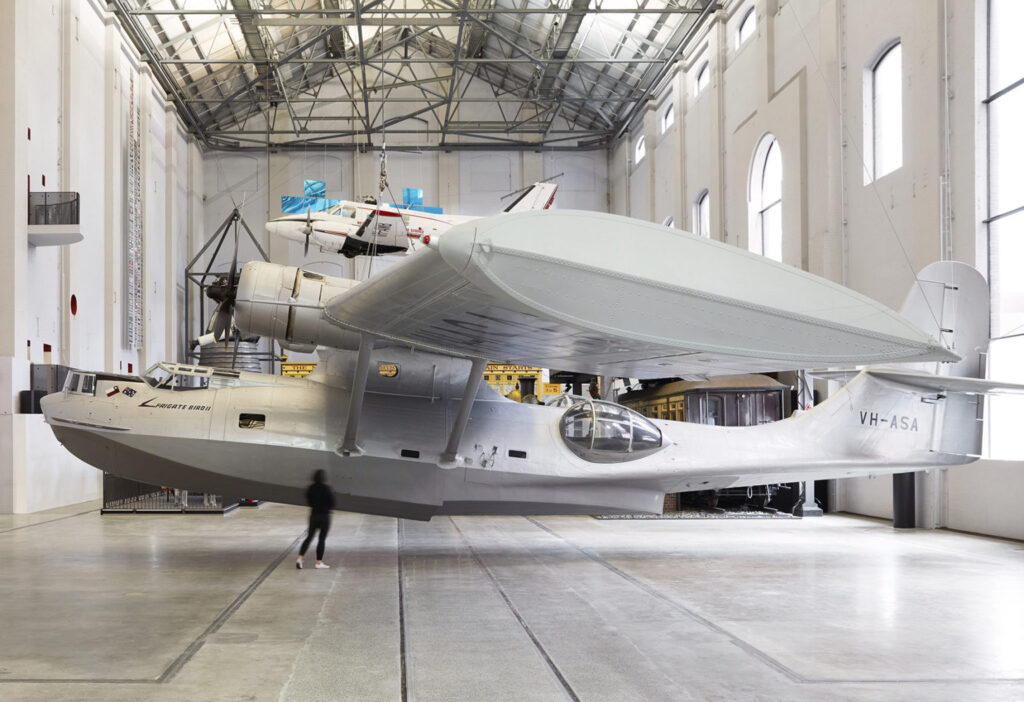
PB2B-2 Catalina VH-ASA Frigate Bird II in its new, temporary position at Sydney’s Powerhouse Museum in August 2022
Zan Wimberley






